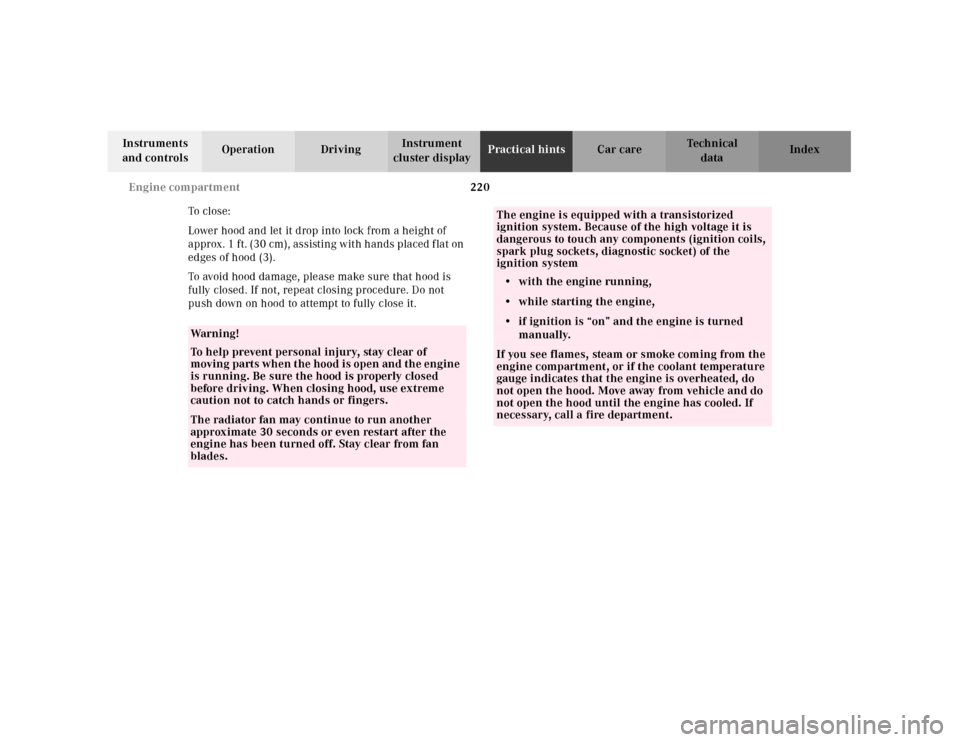Page 26 of 297

23 Instruments and controls
Technical
data Instruments
and controlsOperation DrivingInstrument
cluster displayPractical hints Car care Index 1Side air outlet, adjustable, see page 91
2Level control switch and wheel change switch,
see page 196
3Exterior lamp switch, see page 86
4Parking brake release, see page 175
5Hood lock release, see page 219
6Parking brake pedal, see page 175
7Combination switch, see page 86
8Cruise control switch, see page 185
9Horn
10Airbag, see page 60
11Voice recognition system switch, see separate
operating instructions
12Instrument cluster, see page 74
13Steering lock with ignition/starter switch,
see page 165
14Center air outlets adjustable, see page 91
15Heated air supply button - center air outlet,
see page 9116Non-heated/cooled air supply button - center air
outlet, see page 91
17Storage/eyeglasses compartment, see page 124
18Air volume control for left air outlet, see page 91
19Air volume control for center air outlets, see page 91
20Air volume control for right air outlet, see page 91
21Airbag off indicator lamp, see page 213
22Automatic climate control, see page 90
Rear window defroster switch, see page 95
23Audio system, see page 98
24Trunk lid release switch, see page 40
25Switch for tow-away alarm, see page 43
Indicator lamp for antitheft alarm system,
see page 42
26Central locking switch, see page 37
27Hazard warning f lasher switch, see page 89
28Adaptive damping system adjustment switch,
see page 199
29ESP control switch, see page 194
30Roll bar operation switch, see page 118
Page 65 of 297

61 Restraint systems
Technical
data Instruments
and controlsOperationDrivingInstrument
cluster displayPractical hints Car care Index come on at all or if it fails to extinguish after
approximately 4 seconds or if it comes on thereafter, a
malfunction in the system has been detected.
The following system components are monitored or
undergo a selfcheck: crash-sensor(s), airbag ignition
circuits, seat belt buckles, emergency tensioning
retractors, seat sensor.
Initially, when the key is turned from steering lock
position 0 to positions 1 or 2, malfunctions in the crash-
sensor are detected and indicated (the “SRS” indicator
lamp stays on longer than 4 seconds or does not come
on). In the operational mode, after the indicator lamp
has gone out following the initial check, interruptions or
short circuits in the airbag ignition circuit and in the
driver and passenger seat belt buckle harnesses, and
low voltage in the entire system are detected and
indicated.Have the system checked at your authorized
Mercedes-Benz Center immediately.
Wa r n i n g !
In the event a malfu nction of th e “SRS” is indic ated
as outlined above, the “SRS” may not be
operational. For your safety, we strongly
recommend that you visit an authorized
Mercedes-Benz Center immediately to have the
system checked; otherwise the “SRS” may not be
activated when needed in an accident, which could
result in serious or fatal injury, or it might deploy
unexpectedly and unnecessary which could also
result in injury.
Page 106 of 297

102 Audio system
Technical
data Instruments
and controlsOperationDrivingInstrument
cluster displayPractical hints Car care Index
Operation
Switching on and off
Press the control knob .
Th e ra dio is switch ed of f wh en the ignition key is tu rned
to position 0 or removed from the ignition. The radio is
switched on again when the ignition key is turned to
position 1 or 2.
Note:
The radio can also be switched on even if the ignition
key is not inserted, but will switch itself off
automatically after one hour to conserve vehicle battery
power.
Adjusting the volume
Turn the control knob - Turning the knob clockwise will
increase the volume, counterclockwise will decrease the
volume.Audio functions
The AUD key is used to select the BASS, TREBLE and
BALANCE functions. Settings for bass and treble are
stored separately for the radio, cassette and CD modes.
Tone level settings are identified by the vertical bars.
The center (flat) setting is shown by one longer bar in
the center of the display.
Bass
Press the AUD key repeatedly
until “BASS” appears in the
display.
Treble
Press the AUD key repeatedly
until “TREBLE” appears in th e
display.
Press the “+” key to increase
or the “-” key to decrease the level.
Page 224 of 297

220 Engine compartment
Technical
data Instruments
and controlsOperation DrivingInstrument
cluster displayPractical hintsCar care Index
To cl os e:
Lower hood and let it drop into lock from a height of
a pprox. 1 f t. (30 cm), assisting w it h h ands pla ced f la t on
edges of hood (3).
To avoid hood damage, please make sure that hood is
fully closed. If not, repeat closing procedure. Do not
push down on hood to attempt to fully close it.
Wa r n i n g !
To help prevent personal injury, stay clear of
moving parts wh en t he hood is open and th e engine
is running. Be sure the hood is properly closed
before driving. When closing hood, use extreme
caution not to catch hands or fingers.The radiator fan may continue to run another
approximate 30 seconds or even restart after the
engine has been turned off. Stay clear from fan
blades.
The engine is equipped with a transistorized
ignition system. Because of the high voltage it is
dangerous to touch any components (ignition coils,
spark plug sockets, diagnostic socket) of the
ignition system
• with the engine running,
• while starting the engine,
• if ignition is “on” and the engine is turned
manually.If you see flames, steam or smoke coming from the
engine compartment, or if the coolant temperature
gauge indicates that the engine is overheated, do
not open the hood. Move away from vehicle and do
not open the hood until the engine has cooled. If
necessary, call a fire department.